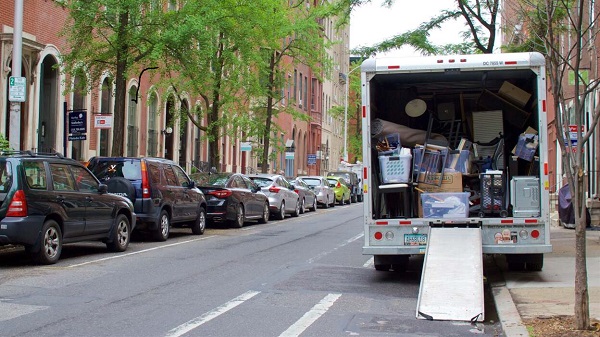Business
What Inter-Provincial Migration Trends Can Tell Us About Good Governance

It turns out we move a great deal less than our American neighbors
Government policies have consequences. Among them is the possibility that they might so annoy the locals that people actually get up and head for the exit. Given how parting can be such sweet sorrow (and how it’s a pain to lose out on all that revenue from provincial income, property, and sales tax), legislatures generally prefer to keep their citizens on this side of the door.
Nevertheless, migration happens. And when enough people do it at the same time, they sometimes leave economic and social clues behind waiting to be discovered. This graph represents net migrations since 1971 into and out of the four largest provinces:
The Audit is a reader-supported publication. To receive new posts and support my work, consider becoming a free or paid subscriber.
It may just be possible to make out some broad patterns here. Quebec has never had a net inbound migration year (although there’s been plenty of immigration to Quebec from outside of Canada). But nothing matches the mass exodus of anglophones due to concerns over language and separation in the 1970s.
Curiously it seems that Alberta and British Columbia received far more migrants than Ontario around that time – although the actual numbers tell us that they were more likely to have come from Saskatchewan and Ontario than Quebec. By contrast, most disillusioned Quebecers found their way to Ontario. Besides the 70s, Alberta also enjoyed inbound spikes in the mid-90s, mid-00s, and early 10s. And it looks like they’re in the middle of another boom cycle as we speak.
The real value of all this data however, is in using it to test causation hypotheses. In other words, can statistical analysis tell us what it was that caused the migrations? And are some or all of those causes the result of government policy choices? Here are some possibilities we’ll explore:
- Household income trends
- Government debt
- Crime rates
- Healthcare costs
- Housing costs
Right off the top I’ll come clean with you: there’ll be no smoking gun here. I could find no single historical measure that came close to explaining migration patterns. However I was able to confidently discard some theories. That’s a win I guess. And other numbers did hint to intriguing possibilities.
Inter-provincial variations in household income, crime rates (specifically murder rates), healthcare costs (including prescriptions, eye care, and dental care), and even housing affordability had no measurable impact on migration. This was true for both correlation coefficients and lag analysis (where we looked at migration changes in the years following an economic event).
Rising unemployment had, at best, a minimal impact on outbound migration. And even then, it was only noticeable for Alberta and Prince Edward Island.
Of all the metrics I explored, the only one that might have had a serious influence in migration was provincial government budget deficits.
Folks from Alberta, New Brunswick, and Newfoundland all responded to growing government debt by clearing out. Now, I doubt this was their way to telling the government what they really thought about bad fiscal management. Rather, people probably decided to move to greener pastures in response to the ripple-effect consequences of deficits, like higher taxes, reduced social services, and deteriorating infrastructure.
I suspect that part of the reason I wasn’t able to find any strong connections between those metrics and migration patterns is because there really isn’t all that much migration going on in the first place.
Take Ontario’s record net population loss of 31,018 residents back in 2021. That may sound like a lot of people, but it’s actually just a hair over two-tenths of one percent of the total Ontario population. And even Quebec’s epic 1979 loss of 46,429 people was still nowhere near one percent. It was 0.7117456, to be precise. Those aren’t significant numbers.
When so few people choose to move, it’s probably because there’s nothing on the macro level going on that’s pushing them. Those who do go, probably do it primarily for personal reasons that just won’t show up in population-scale data.
There’s also the very real possibility that Canadians are smart enough to realize that things probably won’t be any better over there than they already are right here. Fewer than two-thirds of one percent of Ontarians left for other provinces in 2023, while only around one-third of a percent gave up on Quebec.
By contrast, annual state-to-state migration figures in the U.S. typically range between 1 percent to 5 percent of each state’s population. In 2022, that added up to 8.2 million people, according to the Census Bureau.
In the market for bespoke data analysis?
Agriculture
Canada’s supply management system is failing consumers

This article supplied by Troy Media.
The supply management system is cracking. With imports climbing, strict quotas in place and Bill C202 on the table, we’re struggling to feed ourselves
Canada’s supply management system, once seen as a pillar of food security and agricultural self-sufficiency, is failing at its most basic function:
ensuring a reliable domestic supply.
According to the Canadian Association of Regulated Importers, Canada imported more than 66.9 million kilograms of chicken as of June 14, a 54.6 per cent increase from the same period last year. That’s enough to feed 3.4 million Canadians for a full year based on average poultry consumption—roughly 446 million meals. Under a tightly managed quota system, those meals were supposed to be produced domestically. Instead imports now account for more than 12 per cent of this year’s domestic chicken production, revealing a growing dependence on foreign supply.
Supply management is Canada’s system for regulating dairy, poultry and egg production. It uses quotas and fixed prices to match domestic supply with demand while limiting imports, intended to protect farmers from global price swings and ensure stable supply.
To be fair, the avian influenza outbreak has disrupted poultry production and partially explains the shortfall. But even with that disruption, the numbers are staggering. Imports under trade quotas set by the World Trade Organization, the Canada-United States Mexico Agreement and the Comprehensive and Progressive Agreement for Trans-Pacific Partnership are running at or near their allowable monthly share—known as pro-rata
levels—signalling not just opportunity, but urgency. Supplementary import permits, meant to be used only in emergencies, have already surpassed 48 million kilograms, exceeding total annual import volumes in some previous years. This isn’t a seasonal hiccup. It’s a systemic failure.
The system, designed to buffer domestic markets from global volatility, is cracking under internal strain. When emergency imports become routine, we have to ask: what exactly is being managed?
Canada’s most recent regulated chicken production cycle, which ended May 31, saw one of the worst shortfalls in over 50 years. Strict quota limits stopped farmers from producing more to meet demand, leaving consumers with higher grocery bills and more imported food, shaking public confidence in the system.
Some defenders insist this is an isolated event. It’s not. For the second straight week, Canada has hit pro-rata import levels across all chicken categories. Bone-in and processed poultry, once minor players in emergency import programs, are now essential just to keep shelves stocked.
And the dysfunction doesn’t stop at chicken. Egg imports under the shortage allocation program have already topped 14 million dozen, a 104 per cent jump from last year. Not long ago, Canadians were mocking high U.S. egg prices. Now theirs have fallen. Ours haven’t.
All this in a country with $30 billion in quota value, supposedly designed to protect domestic production and reduce reliance on imports. Instead, we’re importing more and paying more.
Rather than addressing these failures, Ottawa is looking to entrench them. Bill C202, now before the Senate, seeks to shield supply management from future trade talks, making reform even harder. So we must ask: is this really what we’re protecting?
Meanwhile, our trading partners are taking full advantage. Chile, for instance, has increased chicken exports to Canada by more than 63 per cent, now accounting for nearly 96 per cent of CPTPP-origin imports. While Canada doubles down on protectionism, others are gaining long-term footholds in our market.
It’s time to face the facts. Supply management no longer guarantees supply. When a system meant to ensure resilience becomes a source of fragility, it’s no longer an asset—it’s an economic liability.
Dr. Sylvain Charlebois is a Canadian professor and researcher in food distribution and policy. He is senior director of the Agri-Food Analytics Lab at Dalhousie University and co-host of The Food Professor Podcast. He is frequently cited in the media for his insights on food prices, agricultural trends, and the global food supply chain.
Troy Media empowers Canadian community news outlets by providing independent, insightful analysis and commentary. Our mission is to support local media in helping Canadians stay informed and engaged by delivering reliable content that strengthens community connections and deepens understanding across the country.
Business
Prairie provinces and Newfoundland and Labrador see largest increases in size of government

From the Fraser Institute
By Jake Fuss and Grady Munro
A recent study found that Canada has experienced one of the largest increases in the size of government of any advanced country over the last decade. But within Canada, which provinces have led the way?
The size of government refers to the extent to which resources within the economy are controlled and directed by the government, and has important implications for economic growth, living standards, and economic freedom—the degree to which people are allowed to make their own economic choices.
Too much of anything can be harmful, and this is certainly true regarding the size of government. When government grows too large it begins to take on roles and resources that are better left to the private sector. For example, rather than focusing on core functions like maintaining the rule of law or national defence, a government that has grown too large might begin subsidizing certain businesses and industries over others (i.e. corporate welfare) in order to pick winners and losers in the market. As a result, economic growth slows and living standards are lower than they otherwise would be.
One way to measure the size of government is by calculating total general government spending as a share of the economy (GDP). General government spending refers to spending by governments at all levels (federal, provincial, and municipal), and by measuring this as a share of gross domestic product (GDP) we can compare across jurisdictions of different sizes.
A recent study compared the size of government in Canada as a whole with that of 39 other advanced economies worldwide, and found that Canada experienced the second-largest increase in the size of government (as a share of the economy) from 2014 to 2024. In other words, since 2014, governments in Canada have expanded their role within the economy faster than governments in virtually every other advanced country worldwide—including all other countries within the Group of Seven (France, Germany, Italy, Japan, the United Kingdom, and the United States). Moreover, the study showed that Canada as a whole has exceeded the optimal size of government (estimated to fall between 24 and 32 per cent of GDP) at which a country can maximize their economic growth. Beyond that point, growth slows and is lower than it otherwise would be.
However, Canada is a decentralized country and provinces vary as to the extent to which governments direct overall economic activity. Using data from Statistics Canada, the following charts illustrate which provinces in Canada have the largest size of government and which have seen the largest increases since 2014.

The chart above shows total general government spending as a share of GDP for all ten provinces in 2023 (the latest year of available provincial data). The size of government in the provinces varies considerably, ranging from a high of 61.4 per cent in Nova Scotia to a low of 30.0 per cent in Alberta. There are geographical differences, as three Atlantic provinces (Nova Scotia, Prince Edward Island, and New Brunswick) have the largest governments while the three western-most provinces (Alberta, Saskatchewan, and British Columbia) have the smallest governments. However, as of 2023, all provinces except Alberta exceeded the optimal size of government—which again, is between 24 and 32 per cent of the economy.

To show which provinces have experienced the greatest increase in the size of government in recent years, the second chart shows the percentage point increase in total general government spending as a share of GDP from 2014 to 2023. It should be noted that this is measuring the expansion of the federal government’s role in the economy—which has been substantial nationwide—as well as growth in the respective provincial and municipal governments.
The increases in the size of government since 2014 are largest in four provinces: Newfoundland and Labrador (10.82 percentage points), Alberta (7.94 percentage points), Saskatchewan (7.31 percentage points), and Manitoba (7.17 percentage points). These are all dramatic increases—for perspective, in the study referenced above, Estonia’s 6.66 percentage point increase in its size of government was the largest out of 40 advanced countries.
The remaining six provinces experienced far lower increases in the size of government, ranging from a 2.74 percentage point increase in B.C. to a 0.44 percentage point increase in Quebec. However, since 2014, every province in Canada has seen government expand its role within the economy.
Over the last decade, Canada has experienced a substantial increase in the size of total government. Within the country, Newfoundland and Labrador and the three Prairie provinces have led the way in growing their respective governments.
-

 Business1 day ago
Business1 day agoLatest shakedown attempt by Canada Post underscores need for privatization
-

 Business1 day ago
Business1 day agoWhy it’s time to repeal the oil tanker ban on B.C.’s north coast
-

 Aristotle Foundation2 days ago
Aristotle Foundation2 days agoHow Vimy Ridge Shaped Canada
-

 Alberta1 day ago
Alberta1 day agoPierre Poilievre – Per Capita, Hardisty, Alberta Is the Most Important Little Town In Canada
-

 International2 days ago
International2 days agoCBS settles with Trump over doctored 60 Minutes Harris interview
-

 Energy1 day ago
Energy1 day agoIf Canada Wants to be the World’s Energy Partner, We Need to Act Like It
-

 MxM News1 day ago
MxM News1 day agoUPenn strips Lia Thomas of women’s swimming titles after Title IX investigation
-

 Alberta1 day ago
Alberta1 day agoAlberta Provincial Police – New chief of Independent Agency Police Service










